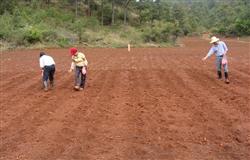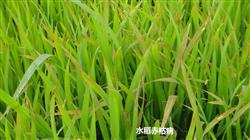How to use herbicide in corn field?

How to use herbicide in corn field? Also ask netizens to help introduce the planting network to sort out the use of herbicides in the corn field and matters needing attention, listed below for your reference. According to the time of application and the principle of weeding, herbicides in corn field can be divided into two categories: herbicide before corn bud and herbicide for stem and leaf treatment after corn seedling. Closed herbicide before corn sprouting: it means that the herbicide is sprayed evenly on the soil surface before the emergence of weeds after corn sowing, before the emergence of weeds or before the 3-leaf stage. Weed seeds distributed on the soil surface will germinate rapidly after rain or watering under suitable temperature conditions, and elongated weed Hypocotyl and buds will be poisoned once they come into contact with the surface. The germination of buds stops or the seedlings die. Corn seeds are generally distributed under 3 cm of the soil surface and will not be poisoned because the Hypocotyl does not come into contact with chemicals under the soil. The common herbicides used in pre-sprout closure of corn include herbicide, trimethoprim, isoproterenol and so on, which have good herbicidal effect on annual broadleaf weeds and gramineous weeds in corn field, but have no effect on persistent root weeds. Corn post-seedling herbicide: refers to the use of weeds and corn on the physiological differences in drug resistance, spraying on the stems and leaves of weeds to cause poisoning and death. Maize has enzymes that can decompose this herbicide to make it have better drug resistance, and make use of this physiological selectivity difference to achieve the goal of weeding and strengthening seedlings. At present, the most widely used corn post-seedling herbicides are nicosulfuron, sulfophenone, 2mae 4murD butyl ester and dimethyl tetrachloride. BASF has launched a safe and effective pyrazolone herbicide in China in recent years. There are many farmers in the application of herbicides to corn fields, not in strict accordance with the technical requirements of drug selection, drug use, the following introduction of herbicide use points for your reference. Note 1: seriously treat and understand the risk and technology of herbicides in order to make good use of herbicides and achieve the goal of truly simple and efficient. Note 2: be sure to read the product description carefully or consult the technician before using it. According to the law of maize growth management and its physiological characteristics, environmental conditions and soil conditions, the most appropriate time to use drugs was selected. For example, spraying closed herbicides under certain soil humidity has the best control effect; the best temperature for herbicides after using nicosulfuron and other seedlings is about 25 ℃, but it is especially easy to cause drug damage when the temperature exceeds 35 ℃. The best time to use 2mae4Mel D and dimethyl tetrachloride herbicides is before and after the 3-leaf stage of maize and the temperature is above 10 ℃. It is easy to cause drug damage when used at low temperature or jointing stage. Note 3: in order to save effort, many people randomly increase the dose of medicine to reduce the amount of spray, which is very wrong. Spray requires that under the premise of a certain fineness, the chemical can evenly cover the soil surface or weed stems and leaves on a certain area, so that it can have a better control effect. The fog droplets emitted by the spray instruments we currently use are relatively thick, and it takes about 100 jin of spray to better cover the target on the area of one mu of land. Even if the dosage of the agent is increased several times and the amount of spray is not enough, the agent will not be evenly distributed. Therefore, the dosage of the medicine can be mastered in accordance with the product instructions, but the amount of spray must not be reduced at will. When spraying nicosulfuron-type post-seedling herbicides, spraying along the ridge and spraying the agents directly on weeds can achieve the goal of labor-saving, safety and high efficiency. Only by strictly abiding by and applying science and technology and making rational use of herbicides can the goal of safety, simplicity, economy and efficiency be achieved. Click to get more corn planting techniques click to get more food crop planting techniques
- Prev

Matters needing attention in sweet potato planting
Matters needing attention in sweet potato planting
- Next

Control of Rice Diseases and insect pests: what is Rice Red Blight?
What is rice red blight? What harm does red blight do to rice? How to control rice red blight? Please introduce the harm of rice red blight: Rice red blight, commonly known as bowing seedlings and setting trees, is a physiological disease in rice production, with obvious dwarfism, small tillers, erect upper leaves and stems.
Related
- The first cup of black tea in spring, the flavor and history of tea gardens in Kenya, Africa
- The computer can not only choose potatoes, but also grow tea rice. AI will grow winter oolong tea champion.
- It is not only the inflated tea bitten by insects, but also engraved with the four seasons tea in Beipu.
- The Oriental Beauty Tea Festival in Zhuxian County takes the stage at the weekend to experience the plus-size feast of oil tea.
- & quot; Oriental Beauty Tea & Exploration of Emei in Hsinchu, the hometown of quot;
- The new variety of strawberry "Tainong 1" dessert is the first choice with mellow aroma. Crimson gorgeous
- History of Tea in Taiwan: from Wild Inner Mountain to Export Tea Garden
- Two types of Taiwan Oriental Beauty Black Tea won the British three-Star Award for Childhood Tea Xiang Zhang Jiaqi changed from pilot to champion tea maker.
- Banana species and varieties: the planting history of Taiwan Xianren banana and dwarf banana is long, is banana disease resistant?
- Coffee planting Technology: Qianjie Coffee from Seedling to harvesting

